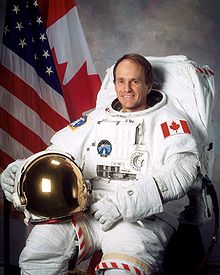Steve MacLean (astronaut): Difference between revisions
Ilikepie2221 (talk | contribs) formatting: 2x whitespace, mdash (using Advisor.js) ; +cite |
No edit summary |
||
| Line 8: | Line 8: | ||
| date_death = |
| date_death = |
||
| place_birth =[[Ottawa]], [[Canada]] |
| place_birth =[[Ottawa]], [[Canada]] |
||
| place_death = |
| place_death =ottawa canada |
||
| occupation = |
| occupation = |
||
| rank = |
| rank = |
||
Revision as of 00:37, 8 October 2008
Steven MacLean | |
|---|---|
 | |
| Status | Active |
| Nationality | Canadian |
| Space career | |
| NRC/CSA Astronaut | |
Time in space | 21d 16h 02m |
| Selection | 1983 NRC Group |
| Missions | STS-52, STS-115 |
Mission insignia | |
Steven Glenwood MacLean (b. December 14, 1954) is a Canadian astronaut. He is the current President of the Canadian Space Agency, appointed on September 2, 2008.[1]
He was born in Ottawa, Ontario and is married to Nadine Wielgopolski of Hull, Quebec. They have three children. He enjoys hiking, canoeing, flying, parachuting and gymnastics.
Personal
MacLean attended Merivale High School in Ottawa. He received a Bachelor of Science degree in physics in 1977 and a doctorate in physics in 1983 from York University in Toronto, Ontario. In 1977, he received the President’s Award at York University (Murray G. Ross Award). He is a recipient of a Natural Sciences and Engineering Research Council post graduate scholarship in 1980, two Ontario graduate scholarships, one in 1981 and the other in 1982, and a Natural Sciences and Engineering Research Council postdoctoral fellowship in 1983.
He is an honorary fellow of Norman Bethune College of York University and president of the board of directors for the Mont Megantic Observatory project.
From 1974 to 1976, MacLean worked in sports administration and public relations at York University. From 1976 to 1977, he was a member of the Canadian National gymnastics team. He taught part-time at York University from 1980 to 1983. In 1983, he became a visiting scholar at Stanford University under Nobel Laureate A.L. Schawlow. He is a laser-physicist, and his research has included work on electro-optics, laser-induced fluorescence of particles and crystals and multi-photon laser spectroscopy.
Astronaut career
In December 1983, MacLean was one of six astronauts selected by the National Research Council of Canada. He began astronaut training in February 1984 and, in December 1985, was designated as the Canadian Payload Specialist to fly with the CANEX-2 set of Canadian experiments in space. MacLean was assigned to mission STS-71-F that scheduled for launch in 1987, but was canceled after Space Shuttle Challenger disaster. His mission, STS-52, took place October 22 to November 1, 1992.
From 1988 to 1991, he was astronaut adviser to the Strategic Technologies in Automation & Robotics Program (STEAR).
From 1987 to 1993, he was program manager of the Advanced Space Vision System (SVS). In July 1992, NASA agreed to outfit the shuttle fleet with an operational version of the Orbiter Space Vision System (OSVS) which will give eyes to the Canadarm on board the space shuttle, and the Advanced Vision Unit (AVU) which will be used with the Mobile Servicing System (MSS). The MSS is Canada’s contribution to the International Space Station. MacLean was Program Manager for the OSVS until his interim assignment, in July 1993, to a collateral duty as Science Advisor for the International Space Station.
In 1993, he became an adjunct professor at the University of Toronto Institute for Aerospace Studies.
In April 1994, he was appointed acting director-general of the Canadian astronaut program. In July 1996 he was selected to attend NASA’s Astronaut Candidate Training at Johnson Space Center in Houston, Texas. Having completed two years of training and evaluation, he is qualified for flight assignment as a mission specialist. MacLean was initially assigned technical duties in the astronaut office robotics branch. More recently, he served as a CAPCOM (spacecraft communicator) in the JSC Mission Control Center.
MacLean served as a Mission Specialist on STS-115, which launched on September 9, 2006 and returned on September 21, 2006. He became the first Canadian to operate the robotic arm Canadarm2. On September 13, he performed his first spacewalk, a 7 hour EVA to activate the solar panels on the P3/4 truss — the second Canadian to do so, after Chris Hadfield.
Honours
In 1993, he received an honorary doctorate from the Collège militaire royal de Saint-Jean in Quebec, York University, Acadia University in Wolfville. In September 2006, Steve MacLean Public School was opened in Ottawa, named after him.
External links
- Canadian Space Agency President's biography
- NASA astronaut biography
- Spacefacts biography of Steven MacLean
- ^ "Steve MacLean named head of space agency". CBC News. Sympatico. 2008-09-02. Retrieved 2008-09-02.
